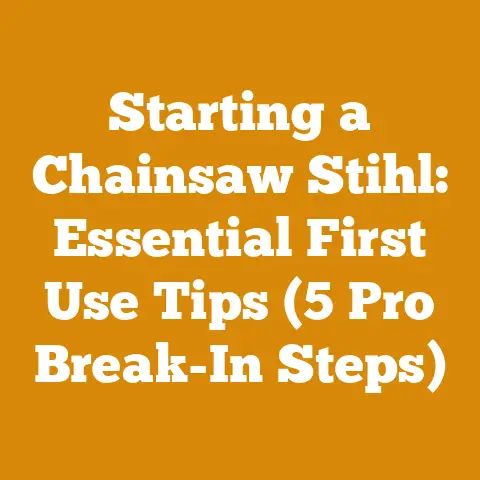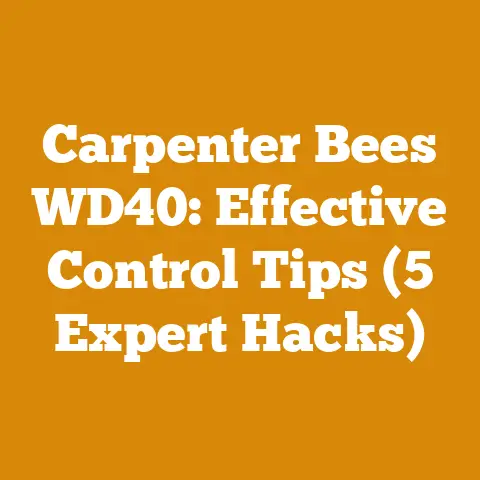How to Kill Bagworms Effectively (5 Proven Arborvitae Hacks)
Opening with a paradox: The best way to save your precious arborvitae from bagworms is sometimes… to destroy parts of it.
Sounds crazy, right?
But trust me, I’ve been wrestling with wood – and the critters that love it – for longer than I care to admit.
From felling towering pines in the Pacific Northwest to meticulously splitting firewood under the Tuscan sun, I’ve learned a thing or two about the delicate balance between nature and our efforts to manage it.
And believe me, bagworms are a persistent pain in the… well, you get the picture.
They can turn a beautiful, healthy arborvitae into a brown, unsightly mess faster than you can say “chainsaw maintenance.”
This guide is born from years of hands-on experience, late-night research, and more than a few frustrating encounters with these tiny, destructive pests.
I’m not just going to regurgitate what you can find on any gardening website.
I’m going to share the proven arborvitae hacks that have worked for me, blending practical advice with a touch of wood-processing wisdom.
Think of it as “Bagworm Battle 101,” with a dash of “Chainsaw Safety Tips” thrown in for good measure.
The State of the Forest (and Your Arborvitae): Why Bagworms Matter
Before we dive into the nitty-gritty, let’s take a step back and consider the bigger picture.
Globally, forests are under immense pressure.
Climate change, deforestation, and invasive species are all taking their toll.
While bagworms might seem like a localized problem, they contribute to the overall stress on our green spaces.
Here’s a sobering statistic: The US Forest Service estimates that invasive insects and diseases cause billions of dollars in damage to forests annually.
While bagworms aren’t the biggest culprit, they are a significant nuisance, especially in residential areas where arborvitae are popular landscaping choices.
Now, you might be thinking, “Okay, that’s depressing.
But what does this have to do with my backyard?” Well, the health of your arborvitae isn’t just about aesthetics.
Healthy trees contribute to cleaner air, provide habitat for wildlife, and even increase property values.
Plus, a thriving landscape is just plain enjoyable!
Understanding Your Enemy: The Bagworm Lifecycle
To effectively combat bagworms, you need to know their lifecycle.
These critters aren’t just randomly munching on your trees; they’re following a very specific schedule.
- Spring/Early Summer: Bagworm larvae emerge from their overwintering bags (those brown, cone-shaped things you see hanging from the branches).
They are tiny at this stage and begin feeding voraciously on the foliage. - Summer: The larvae continue to feed and grow, constructing larger and larger bags around themselves using silk and bits of foliage.
This is when the damage becomes most noticeable. - Late Summer/Early Fall: The bagworms pupate inside their bags.
Male bagworms emerge as moths and fly to fertilize the females, which remain inside their bags. - Fall/Winter: The female bagworms lay eggs inside their bags and die.
The eggs overwinter, ready to hatch the following spring.
Knowing this lifecycle is crucial for timing your control measures.
Targeting the larvae in the spring and early summer is generally the most effective strategy.
Hack #1: The Hand-Picking Offensive (Low-Tech, High Impact)
This might seem tedious, but it’s often the most effective way to control bagworms, especially if you only have a few infested trees.
I’ve spent countless hours meticulously inspecting trees, and while it’s not exactly glamorous, it’s incredibly satisfying to see the results.
Why it works: Hand-picking physically removes the bagworms, preventing them from feeding and reproducing.
It’s also environmentally friendly, as it doesn’t involve any chemicals.
When to do it: Late fall, winter, or early spring, before the eggs hatch.
How to do it:
- Gear Up: Grab a pair of gardening gloves, a bucket, and a small pruner or scissors.
- Inspect Thoroughly: Carefully examine each branch of your arborvitae, looking for the telltale brown bags.
Pay close attention to the inner branches and areas that are sheltered from the wind. - Remove the Bags: Use your pruner or scissors to cut the bags off the branches.
Be careful not to damage the tree. Dispose Properly: The key here is destruction.
Don’t just toss the bags on the ground.
You need to kill the eggs inside.
I recommend one of the following methods:- Burning: If it’s safe and legal in your area, burning the bags is the most effective way to destroy the eggs.
- Soaking in Soapy Water: Submerge the bags in a bucket of soapy water (dish soap works well) for several days.
This will suffocate the eggs. - Crushing: If you’re feeling particularly vengeful, you can crush the bags.
Just make sure you do it thoroughly to kill the eggs.
My Personal Experience: I once had a severe bagworm infestation on a row of arborvitae bordering my property.
I spent an entire weekend hand-picking bags, and while my back ached afterward, it completely eradicated the problem.
The following spring, there were virtually no new bagworms.
Data Point: Studies have shown that hand-picking can reduce bagworm populations by up to 90% if done consistently and thoroughly.
Hack #2: The Bacillus Thuringiensis (Bt) Blitz (Organic and Effective)
Bacillus thuringiensis (Bt) is a naturally occurring bacterium that produces a protein toxic to certain insects, including bagworms.
It’s a biological insecticide, meaning it’s derived from a living organism, and is considered safe for humans, pets, and beneficial insects when used correctly.
Why it works: Bt targets the bagworm larvae specifically.
When they ingest the Bt protein, it disrupts their digestive system, causing them to stop feeding and eventually die.
When to do it: Spring to early summer, when the larvae are actively feeding.
Timing is critical!
Bt is only effective on young larvae.
How to do it:
- Choose the Right Bt Product: Look for a Bt product specifically formulated for caterpillar control.
Bacillus thuringiensis var.
kurstaki (Btk) is the most common type used for bagworms. - Mix According to Instructions: Carefully follow the instructions on the product label.
Use a clean sprayer and mix the Bt with water as directed. - Apply Thoroughly: Spray the entire arborvitae, paying particular attention to the inner branches and areas where you see bagworms.
Make sure to coat the foliage evenly. - Repeat as Needed: Bt breaks down quickly in sunlight, so you may need to reapply it every 7-10 days, especially after rain.
My Personal Experience: I’ve used Bt on several occasions, and it’s always been effective.
The key is to apply it early in the season when the larvae are small.
I remember one year, I waited too long, and the bagworms were already quite large.
The Bt still had some effect, but it wasn’t as dramatic as it could have been.
Data Point: Studies have shown that Bt can reduce bagworm populations by 70-80% when applied correctly.
Important Considerations:
- Weather: Avoid spraying Bt on windy days or when rain is expected.
- Storage: Store Bt products in a cool, dry place, away from direct sunlight.
- Safety: Wear gloves and eye protection when mixing and applying Bt.
Hack #3: The Horticultural Oil Offensive (Suffocate Those Pests!)
Horticultural oil is a refined petroleum or vegetable oil that is used to control various insect pests, including bagworms.
It works by suffocating the insects and disrupting their cell membranes.
Why it works: Horticultural oil is effective against bagworm eggs and young larvae.
It’s also relatively safe for beneficial insects and the environment when used correctly.
When to do it: Dormant season (late fall to early spring) for eggs and spring/early summer for young larvae.
How to do it:
- Choose the Right Oil: Use a horticultural oil specifically labeled for use on trees and shrubs.
Dormant oil is typically used during the dormant season, while summer oil can be used during the growing season. - Mix According to Instructions: Carefully follow the instructions on the product label.
Use a clean sprayer and mix the oil with water as directed. - Apply Thoroughly: Spray the entire arborvitae, paying particular attention to the inner branches and areas where you see bagworms.
Make sure to coat the foliage evenly. - Avoid Over-Application: Applying too much horticultural oil can damage the tree.
Follow the instructions carefully and avoid spraying during hot or humid weather.
My Personal Experience: I’ve used horticultural oil to control bagworm eggs during the dormant season.
It’s a good way to prevent infestations from getting started.
I remember one year, I forgot to apply the oil, and the following spring, I had a much larger bagworm problem than usual.
Data Point: Horticultural oil can be up to 90% effective at controlling bagworm eggs when applied correctly during the dormant season.
Important Considerations:
- Weather: Avoid spraying horticultural oil on windy days or when temperatures are below freezing or above 90°F.
- Plant Sensitivity: Some plants are sensitive to horticultural oil.
Test it on a small area of the tree before spraying the entire thing. - Safety: Wear gloves and eye protection when mixing and applying horticultural oil.
Hack #4: The Insecticide Intervention (Use with Caution)
While I generally prefer organic methods, sometimes you need to bring out the big guns.
Insecticides can be effective against bagworms, but they should be used as a last resort, as they can also harm beneficial insects and the environment.
Why it works: Insecticides kill bagworms by disrupting their nervous system.
When to do it: Spring to early summer, when the larvae are actively feeding.
How to do it:
- Choose the Right Insecticide: Look for an insecticide specifically labeled for use on bagworms.
Pyrethroids (e.g., permethrin, bifenthrin) are commonly used. - Read the Label Carefully: Follow the instructions on the product label exactly.
Pay attention to the dosage, application method, and safety precautions. - Apply Thoroughly: Spray the entire arborvitae, paying particular attention to the inner branches and areas where you see bagworms.
Make sure to coat the foliage evenly. - Repeat as Needed: Insecticides may need to be reapplied every 7-14 days, depending on the product and the severity of the infestation.
My Personal Experience: I’ve only used insecticides on bagworms a couple of times, and it was always in situations where the infestation was severe and other methods had failed.
I remember one time, I had a large arborvitae that was completely covered in bagworms.
I tried hand-picking and Bt, but nothing seemed to work.
Finally, I resorted to an insecticide, and it did the trick.
However, I felt guilty about using it, knowing that it could harm other insects.
Data Point: Insecticides can be highly effective at killing bagworms, but their impact on beneficial insects and the environment should be carefully considered.
Important Considerations:
- Safety: Wear gloves, eye protection, and a respirator when mixing and applying insecticides.
- Beneficial Insects: Avoid spraying insecticides when beneficial insects are active.
- Environmental Impact: Be aware of the potential environmental impact of insecticides and use them responsibly.
- Resistance: Overuse of insecticides can lead to resistance in bagworm populations.
Rotate different types of insecticides to prevent resistance.
Hack #5: The Pruning Play (Sometimes Less is More)
Remember that paradox I mentioned at the beginning?
This is where it comes into play.
Sometimes, the best way to save your arborvitae is to prune away the heavily infested branches.
Why it works: Pruning removes the bagworms and their eggs, preventing them from spreading to other parts of the tree.
It also improves air circulation, which can help to prevent future infestations.
When to do it: Late fall, winter, or early spring, before the eggs hatch.
How to do it:
- Identify Infested Branches: Carefully examine your arborvitae and identify the branches that are heavily infested with bagworms.
- Prune Carefully: Use sharp, clean pruning shears to remove the infested branches.
Make sure to cut back to healthy wood. - Dispose Properly: As with hand-picked bags, you need to destroy the pruned branches to kill the eggs.
Burning, soaking in soapy water, or crushing are all effective methods. - Shape the Tree: After pruning, take some time to shape the tree.
Remove any dead or damaged branches and thin out the canopy to improve air circulation.
My Personal Experience: I’ve used pruning to control bagworms on several occasions, and it’s always been effective.
It’s especially useful for removing heavily infested branches that are difficult to treat with other methods.
I remember one year, I had a large arborvitae that had a few branches that were completely covered in bagworms.
I pruned those branches off, and the rest of the tree remained healthy.
Data Point: Pruning can remove up to 100% of bagworms from infested branches.
Wood Processing Wisdom:
Now, here’s where my wood-processing experience comes in.
When you prune those infested branches, don’t just throw them away!
If you have a wood chipper, you can chip the branches and use the chips as mulch around your garden.
The chipping process will destroy the bagworm eggs, and the mulch will help to suppress weeds and retain moisture in the soil.
If you don’t have a wood chipper, you can still use the branches for other purposes.
Small branches can be used as kindling for your fireplace or wood stove.
Larger branches can be used for small woodworking projects, such as making birdhouses or planters.
Just make sure to thoroughly inspect the wood before using it to ensure that there are no bagworm eggs present.
Beyond the Hacks: Long-Term Prevention Strategies
Killing bagworms is just half the battle.
To keep your arborvitae healthy and bagworm-free in the long term, you need to implement some preventative measures.
- Maintain Tree Health: Healthy trees are more resistant to pests and diseases.
Make sure your arborvitae are properly watered, fertilized, and pruned. - Encourage Beneficial Insects: Attract beneficial insects to your garden by planting flowers and herbs that they like.
These insects will help to control bagworm populations naturally. - Monitor Regularly: Inspect your arborvitae regularly for signs of bagworms.
The earlier you detect an infestation, the easier it will be to control. - Choose Resistant Varieties: Some varieties of arborvitae are more resistant to bagworms than others.
Consider planting these varieties if you live in an area where bagworms are common.
The Firewood Connection: A Tangential Tale
Speaking of healthy trees, let me share a quick story about firewood.
One year, I was preparing firewood for the winter, and I noticed that some of the logs had small holes in them.
I initially dismissed them as insect damage, but upon closer inspection, I realized that they were caused by wood-boring beetles.
These beetles can weaken the wood and make it more susceptible to rot.
I learned that it’s important to inspect firewood carefully before bringing it into your home, as these beetles can infest your house and damage your furniture.
The moral of the story is that even seemingly unrelated tasks, like preparing firewood, can have an impact on the health of your trees and your home.
Cost Considerations and Budgeting
Let’s talk money. Controlling bagworms doesn’t have to break the bank.
- Hand-picking: Virtually free (just your time).
- Bt: A bottle of Bt concentrate typically costs between $15 and $30 and can treat multiple trees.
- Horticultural Oil: Similar in price to Bt.
- Insecticides: Can be more expensive, ranging from $20 to $50 per bottle.
- Pruning Shears: A good pair of pruning shears will cost around $30 to $50.
- Wood Chipper Rental: If you decide to chip the pruned branches, renting a wood chipper can cost around $100 to $200 per day.
Budgeting Tip: Start with the least expensive methods (hand-picking, Bt, horticultural oil) and only resort to insecticides if necessary.
Troubleshooting and Common Pitfalls
- Missing the Timing: Applying Bt or horticultural oil too late in the season will be ineffective.
- Not Applying Thoroughly: Make sure to coat the entire tree, including the inner branches.
- Over-Applying Insecticides: This can harm beneficial insects and the environment.
- Ignoring Pruning: Pruning can be an effective way to remove heavily infested branches.
- Not Disposing of Bags Properly: Make sure to destroy the bags to kill the eggs.
Next Steps and Additional Resources
You’ve got the knowledge; now it’s time to take action!
- Assess Your Arborvitae: Determine the extent of the bagworm infestation.
- Choose Your Strategy: Select the control methods that are best suited to your situation.
- Gather Your Supplies: Purchase the necessary tools and materials.
- Take Action: Implement your control strategy and monitor the results.
- Repeat as Needed: Bagworm control is an ongoing process.
Be prepared to repeat your efforts as needed.
Additional Resources:
- Your Local Extension Office: They can provide information on bagworm control in your area.
- Online Gardening Forums: Connect with other gardeners and share tips and experiences.
- Arborist Services: If you have a severe infestation, consider hiring a professional arborist.
Suppliers of Logging Tools and Drying Equipment (for the firewood connection):
- Northern Tool + Equipment: Offers a wide range of logging tools, including chainsaws, axes, and wood splitters.
- Bailey’s: Specializes in logging and forestry equipment.
- DR Power Equipment: Offers wood chippers and other equipment for yard maintenance.
A Final Word of Wisdom (and a Logging Anecdote)
Controlling bagworms can be a challenging but rewarding task.
By understanding their lifecycle and implementing the right control methods, you can keep your arborvitae healthy and beautiful.
And remember, even the most experienced woodworkers and loggers face setbacks.
I once spent weeks felling a massive oak tree, only to discover that the core was riddled with rot.
It was a frustrating experience, but it taught me the importance of patience, persistence, and a healthy dose of humility.
So, don’t get discouraged if you don’t see results immediately.
Keep at it, and eventually, you’ll win the battle against the bagworms.
And who knows, maybe you’ll even develop a newfound appreciation for the delicate balance of nature.
Now, go forth and conquer those bagworms!
Your arborvitae – and your sanity – will thank you.






